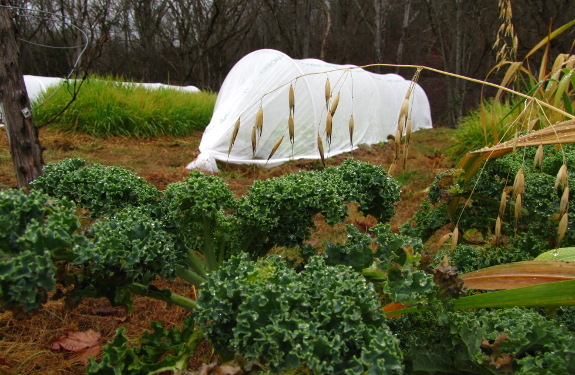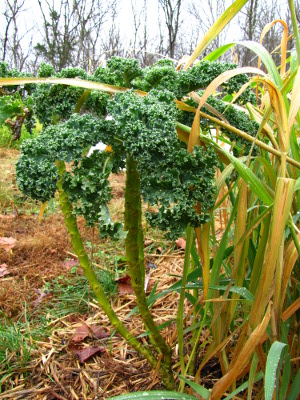
Perennial kale

There are a lot of
perennials with leaves that can be used as greens, but I have to admit
that I prefer the flavor of our annual
greens most of the
time. So you can imagine how excited I was upon hearing of
perennial kale --- perhaps it could be my answer to the early
spring greens shortage?
 And then reality set
in. Eric
Toensmeier tried out several varieties of perennial brassicas in
his Massachusetts garden with very little luck and concluded that they
are only reliably winter hardy to zone 8 or 9. At the same time,
the perennial brassicas detest heat, so he only recommends the
currently available varieties for gardeners in the Pacific Northwest.
And then reality set
in. Eric
Toensmeier tried out several varieties of perennial brassicas in
his Massachusetts garden with very little luck and concluded that they
are only reliably winter hardy to zone 8 or 9. At the same time,
the perennial brassicas detest heat, so he only recommends the
currently available varieties for gardeners in the Pacific Northwest.
However, Toensmeier
challenged us all to develop a new perennial brassica that can
withstand hot summers and cold winters. Brassica
oleracea already
contains a heaping handful of annual and perennial species and he
suspects experimental crosses might yield the perennial holy kale...I
mean grail.
To that end, when some
kale plants overwintered last year, I left them alone. Most
bloomed and died (kale is a biennial --- that's what it does), but one
survived and kept plugging along. I can't actually remember
whether this kale bloomed and I picked off the blooms or if it just
kept growing. All I know is that I've been harvesting a few
leaves from my kale plant off and on for the last twelve months.
Will it survive the winter again unprotected? Will it skip
blooming again and prove itself a true perennial? Only time will
tell.
Want more in-depth information? Browse through our books.
Or explore more posts by date or by subject.
About us: Anna Hess and Mark Hamilton spent over a decade living self-sufficiently in the mountains of Virginia before moving north to start over from scratch in the foothills of Ohio. They've experimented with permaculture, no-till gardening, trailersteading, home-based microbusinesses and much more, writing about their adventures in both blogs and books.
Want to be notified when new comments are posted on this page? Click on the RSS button after you add a comment to subscribe to the comment feed, or simply check the box beside "email replies to me" while writing your comment.

I can confirm marvellous success overwintering kale in zone 6, in a semi-arid region of Canada. I mention that it's semi-arid because we get very little snow cover, and yet our kale plants were happy all throughout the winter, even four feet up the stalk. The variety was 'Rainbow Lacinato', and a curious thing that I noticed was that as the weather got colder, the leaves turned a deep purple. I wonder if the colouring some sort of antifreeze chemical that the purple varieties have?
Now it's the end of the second summer for one of these kale plants, and it's still not dead. I'm going to leave it in the garden for a second winter and see if it's truly perennial. I've heard that perennial kale can be bitter, but this is the loveliest kale you ever did taste.
Did you have any success overwintering the solitary survivor for a second winter? I'd be very curious whether it flowered, and whether it survived. It looks a lot like our Rainbow Lacinato, only a much lighter green.
(Oh, one other thing I thought I'd mention: this spring after our surviving plants came back to life, they produced mostly flowers and not a lot of leaves. So perhaps this wasn't a very useful experiment for us
Paul --- I'll have to try some laciniato kale. We grew Red Russian and Dwarf Siberian last winter, which did beautifully under quick hoops. (We're in zone 6 too.)
Our possibly perennial kale overwintered again, but like yours, it didn't produce many leaves the next summer, so I eventually pulled it out. It did try to flower, but I plucked off the blooms and it eventually gave up, but still didn't make many leaves.
Hm, that's kinda sad -- I guess the search for a truly useful perennial kale goes on It'd be fun to try breeding something like that!
It'd be fun to try breeding something like that!
We had some Red Russian kale as well, and some of it overwintered, but it didn't fare too well either before or after the winter. It seems to be less drought-tolerant than Lacinato.
Wanted to give you an update on some perennial kale I've been working on even if this thread is a bit old.
Since 2010, I've been collecting perennial kales and interbreeding them to create a more reliable perennial kale mix (grex) that can be grown by seed. Along the way, the kale has been adapted for disease and insect resistance, drought and heat tolerance, and cold hardiness - while maintaining good flavor. It's a tall order, but after a lot of hard work and selection, I'm now offering seed of a mix of diverse colors and leaf shapes of perennial bush kale that will be grow and reliably survive zone 6 winters as well as several months of heat waves with no water. It's bushing nature allows it to endure heavy deer pressure and consequently could be used as an animal forage crop as well. But, there is more work to do and that's how you can get involved! By working together, the best perennials that thrive in all sorts of climates can be found, vegetatively propagated, and bred to select to continue improvements at an even faster pace!
I've created a project over at the Experimental Farm Network where you can sign up, get seeds, and help collaboratively select and breed the next generation of better perennial kale that will survive in colder zones or more tropical environments.
You can see pictures, get seeds, learn more, and join the project here: https://www.experimentalfarmnetwork.org/project/14